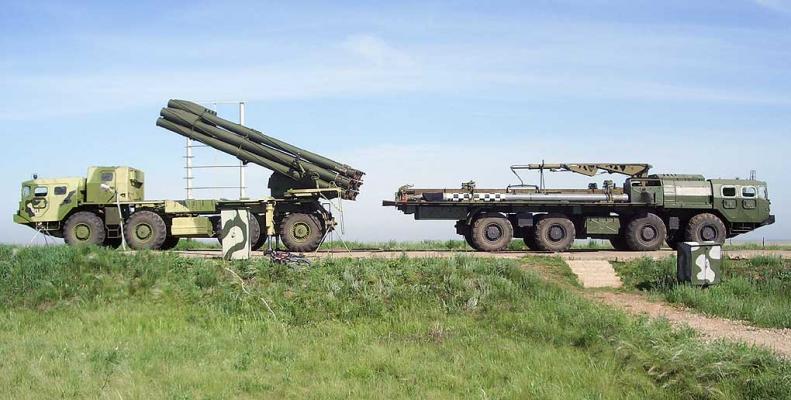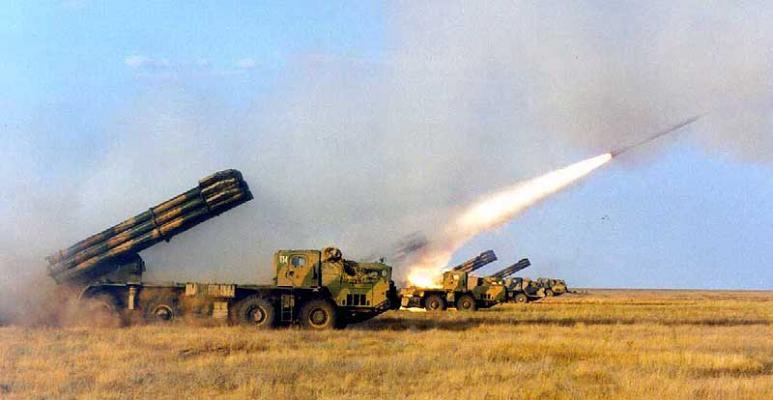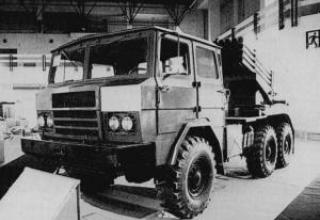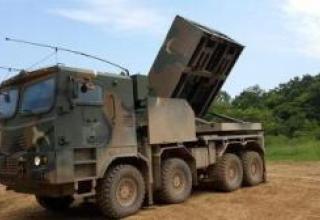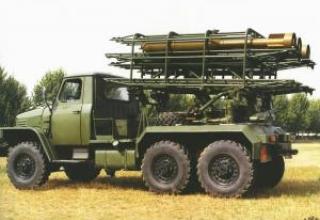The Smerch Multiple Rocket Launcher System (MRLS) is designed to engage distant approaches of any group targets, the vulnerable elements of which are open and concealed manpower, armoured, lightly armoured and armoured vehicles of infantry and tank companies, artillery units, tactical missiles, anti-aircraft systems and helicopters in parking lots, destruction of command posts, communication centers and facilities of the military industrial structure.
In the period from 1969 to 1976, the team of "TULGOSNITOCHMASH" together with specialists of related enterprises conducted research work to study the possibility of creating and defining the appearance of the RSZO reserve of the General Command. The Decree of the CPSU Central Committee and the USSR CM No.1043-361 on the beginning of the Design Bureau for the development of a multiple launch rocket system "Smerch" was issued on December 16, 1976. The design started under the supervision of A.N. Ganichev, General Designer of the State Enterprise "Splav", and ended under the supervision of G.A. Denezhkin. At the end of December 1982 the "Smerch" system successfully passed the state tests. The "Smerch" system was adopted by the Soviet Army on the basis of Decree of the CPSU Central Committee and the USSR CM No 1316-323 of November 19, 1987 and Order of the Minister of Defence No 0334 of December 30, 1987.
A number of fundamentally new technical solutions, embodied in the design of this system and the rocket projectile, makes it possible to refer it to a completely new generation of weapons of this kind. In creating the MLRS, the Americans concluded that the range of 30-40 km is the limit for MLRS. Its further increase leads to too much dispersion of projectiles. The rockets developed for Smerch MLRS have a unique design that ensures hit accuracy 2-3 times higher than that of foreign rockets. For the first time the shells of the Soviet rocket artillery became corrected. Inertial control system was used in their design, providing angular stabilization of the projectiles in the active section of the trajectory and range correction by correction to the time of separation of the head unit, determined by the onboard equipment in accordance with the measured parameters of the projectile movement. Thanks to its use, improvements in the heights and accuracy of firing were obtained as compared to the uncontrolled rockets of previous generations. Mixed solid propellant for the rocket engine was also used for the first time in the RS RA design, thanks to the high-energy characteristics of which the range of flight was increased (internal channels of charges are different), as well as a stabilizer unit with six opening blades. The combat vehicle structures were used for the first time: a docking mechanism in the guide rail design, designed for docking (unhooking) connectors, providing electrical connection between onboard equipment of the projectile and ground preparation and launch equipment, designed to control the docking of the projectile to the guide rail, checking the firing circuits, entering the data of the flight mission and launch production; a guide rail with two guide grooves; a device on the tray of the back pack of guides for determining the temperature of the projectile charge. Later the device-witness was used in the construction of the automated gun of the RMA "Grad", mounted on the cradle; control cabin; protection, allowing to fire in the conditions of the enemy's use of chemical, bacteriological and nuclear weapons with the subsequent degassing of equipment and sanitary treatment of the personnel; holders on the rear inner panel of the cabin for mounting a grenade launcher, machine gun and grenade launcher; supports in the construction of the combat vehicle for mounting a grenade launcher, machine gun and machine gun.
As in the regular M-21OF Grad and 9K27K Uragan missiles, the missile part is a single-chamber, consisting of two pipes. Previously, the author's data on the dual-chamber rocket engine for the Smerch RSZO are unreliable [5, P.55].
The 9K58 Smerch rocket launcher is close to tactical missile systems due to its long range and target acquisition efficiency, so it was tested and adopted by the 42202 military unit.
In 1989, the second version of the Smerch system was adopted for service with the 9A52-2 combat vehicle and 9T234-2 transport and charge vehicle.
At the exhibition DSA 90 (Defense Services Asia, Kualo Lumpur, Malaysia) foreigners were first shown a photo of Smerch combat vehicle (see translation and original).
By the end of the 80-s of the XX century - the first half of the 90-s of the XX century we can refer a series of theoretical works to substantiate the principles of creating a guided missile with self- aiming combat elements, for which in 1995 Blinov Gennady Ivanovich (NPO "Splav", now JSC "NPO "SPLAV" (Tula) became the Laureate of the prize named after V.I. Lenin. S.I. Mosin Prize
In the course of work carried out by the State Enterprise "Splav" on a competitive basis with the State Unitary Enterprise "KBP" to create a high-precision product to the system "Smerch" was developed a combined system, which successfully combined the system of angular stabilization, worked out on the basis of the projectile to the RSZO "Smerch", with a newly created radio control system in the final section of the trajectory. The field tests carried out confirmed the correctness of the principal solutions incorporated in the design and the possibility of controlling the flight of projectiles of this class. According to the results of the project competitive review, the shell developed by the specialists of FSUE "SSPP "Splav" was recommended by the customer for further development.
Another area of research from 1991 to 1996 was the design development of a promising high-energy engine with automatic regulation of intra-chamber processes, allowing to increase the full thrust pulse. Candidate of Technical Sciences Yu.I. Chasovnikov was in charge of this work. The development has interspecific character and can be used in the interests of the Army, Air Force and Navy. Later, as part of the research "Flank", was confirmed the possibility of using this engine in RSZO "Hurricane" and "Smerch".
At the end of the 90s, research and development work was begun on the development of a guided missile for the Smerch system.
At present, Smerch RDC is in service with the armies of Russia, Azerbaijan (30), Armenia (6), Ukraine (94 systems, no data on the results of the Donbas war), Belarus (40), Peru (10), Algeria (18), Kuwait (27), United Arab Emirates (6), Syria, Turkmenistan, Venezuela. In November 1995, a contract was signed for the supply of Smerch to China, which was implemented. There is no public information about its adoption by the Chinese People's Liberation Army.
MLRS "Smerch" was used during military conflicts in the Chechen Republic, Syria, Ukraine, Nagorno-Karabakh.
In 2006, the Special Faculty of the Mikhailovsky Military Artillery Academy (MMAA, St. Petersburg, Russia) held group courses with students from India on impact management of MLRSs.
In 2007, at the training center, employees of the special faculty of MBAA conducted practical classes on BM RSE "Smerch" with students of academic courses from India.
In 2010, in the training center the staff of the MBAA special faculty conducted practical classes in Smerch MFR with the students of academic courses from Turkmenistan.
In 2013, the staff of the MBAA special faculty conducted practical classes on BM Smerch with the students of academic courses from Azerbaijan in the 3rd campus.
In order to organize serial production of hull parts of Hurricane and Smerch RSFs, the industry enterprises purchased specialized mills of PPT-200, PPT-200S, PPT-350 and others, which, according to data for 2005, were successfully used at a number of enterprises for the production of hull parts.
Composition:
Smerch RDC includes the following combat vehicles:
- Fighting vehicle (BM) 9A52 or 9A52-2 (see diagram) ;
- Transport Charger (TZM) 9T234 or 9T234-2 (see layout diagram, in walking position, in operating position) ;
- 300-mm rockets ;
- Training means 9F827;
- Set of special arsenal equipment and tools 9F819;
- Automated fire control system (ALCS) 9С729М1 "Slepok-1" (see description of ALCSM MP32М1 KSAUO).
- Car for topographic survey 1T12-2M;
- Radiation direction finding meteorological complex 1B44.
Originally, a 79111 modified chassis 8x8, also known as Oplot, was used for the launch vehicle 9A52 of the 9K58 Smerch MRS, and a 79112 modified chassis 8x8 was used for the 9T234 transporter loader vehicle. These chassis were produced at the Minsk Automobile Plant (MAZ) in Belarus. Later, for the combat vehicle 9A52-2 and TZM 9T234-2 were used modified chassis of trucks MAZ-543M 8x8 and MAZ-543A 8x8. On the MAZ-543M and MAZ-543A chassis was installed a 12-cylinder 4-cylinder liquid-cooled diesel engine (diesel engine D12A-525A) with direct fuel injection of 525 hp. Cabins of MAZ-543M and MAZ-543A chassis were made of polyester resin, reinforced with fiberglass cloth. MAZ-543M chassis was equipped with a control cabin when used as a base of the combat vehicle 9A52-2. The cabin was equipped with radio communication facilities and fire control system equipment. See the image gallery of the 9A52 Smerch launch vehicle.
The artillery unit consists of a package of 12 tubular rails, swivel base, lifting, swivel and balancing mechanisms, sighting devices, electric drive and auxiliary equipment. The guide rails are smooth wall tubes, equipped with a screw U-slot for propulsion of projectiles. With the help of power-driven guidance mechanisms the guide package can be guided in the vertical plane in the range of angles from 0° to +55°. The horizontal firing angle is 60° (30° to the left and right of the longitudinal axis of the machine). Hydraulic supports are mounted between the wheels of the third and fourth axles, on which the aft part of the launcher is hanged to increase its stability during firing.
In order to charge the starting unit the 9K58 "Smerch" RSZO includes the 9T234-2 transport and charging machine. This machine has crane equipment and transports twelve shells. The charging process of the launcher is mechanized and is performed within 36 minutes.
300 mm shells of Smerch RSZO have a classic aerodynamic layout (see diagram) and are equipped with an efficient solid fuel engine with mixed fuel. Distinctive feature of the projectiles is the presence of a flight control system that corrects the trajectory of pitch and yaw (see the scheme of electronic-temporal device and control system unit). Due to the use of this system, the accuracy of Smerch hits has been increased 2 times (not exceeding 0.21% of the salvo range, i.e. about 150m, which brings it closer to artillery guns in terms of accuracy), and the heap rate of fire - 3 times. The correction is carried out by gas-dynamic rudders, driven by high-pressure gas from the onboard gas generator. Besides, stabilization of the projectile in flight is carried out due to its rotation around the longitudinal axis, which is provided by pre-twisting during the movement on the tubular guide and supported in flight by installing the blades of the opening stabilizer at an angle to the longitudinal axis of the projectile.
The following types of projectiles are included in the ammunition:
- With a flying range of up to 70 km:
- 9M55F projectile with detachable shrapnel-flash HF;
- projectile 9M55K with detachable shrapnel-type HF;
- projectile 9M55K1, with cluster warheads equipped with Motivation 3M self aiming warheads (see trajectory diagram);
- Missile ordnance 9M55K3 with cluster warheads for antipersonnel mine clearance;
- projectile 9M55K4 with cassette warhead for anti-tank mining;
- projectile 9M55K5 with cluster warheads equipped with cluster-shrapnel warheads;
- projectile 9M55K6 with cluster warheads equipped with 9H self- aiming warheads268 ;
- projectile 9M55K7 with cluster warheads equipped with small self- aiming self aiming warheads;
- projectile 9M55C with thermobaric HF;
- Variants of the following projectiles with a range of up to 90 km were under development, most of which remained design work:
- projectile 9M525 with cluster warheads equipped with fragmentation type warheads;
- projectile 9M526 with cluster warheads equipped with Motive 3M self aiming warheads.
- projectile 9M527 with cassette HF for anti-tank mining of the area;
- projectile 9M528 with detachable shrapnel-phase HF;
- projectile 9M529 with thermobaric HF;
- projectile 9M530 with penetrating blast HF;
- projectile 9M531 with a cassette HF equipped with cumulative shrapnel warheads;
- projectile 9M532, with cluster warheads equipped with small-size self- aiming warheads;
- projectile 9M533 with cluster warheads equipped with self- aiming 9H268 warheads;
- projectile 9M534, equipped with a small-size reconnaissance unmanned aerial vehicle;
- projectile 9M536, with cluster warheads equipped with penetrating shrapnel warheads;
- Missile missile 9M537, with cluster warheads equipped with shrapnel warheads;
- The projectile with a range of up to 120 km was designed for a foreign customer.
- projectile 9M542 with a non-explosive fragmentation head end.
Shots may be fired in single shells or in volley. The salvo of one car covers the area of 672 thousand square meters.
The modernization of BM 9A52-2 with regard to the introduction of combat control and communication equipment (ABUS) and the Automated Guidance and Fire Control System (AHMS) made it possible to provide additional equipment:
- automated high-speed reception (transfer) of information and protection of it from unauthorized access, visual display of information on the board and its storage;
- Autonomous top binding and orientation of the PM on the ground with the display on an electronic map;
- automated calculation of firing settings and flight task data;
- aimless guidance of the guide package without leaving the cabin.
An important contribution to improving the combat efficiency of Smerch RDC was made by the automated fire control system Vivarium, developed and produced by Tomsk Kontur Production Association. This system combines several command and staff vehicles at the disposal of the RSZO brigade commander and chief of staff, as well as subordinate division commanders (up to three) and batteries (up to eighteen). Each of these vehicles is based on the KAMAZ-4310 vehicle and has a digital E-715-1.1 computer, displays, printers, communication equipment and secreting communication equipment. The machines have autonomous power supply systems in position and in motion.
The equipment of command and staff machines of the "Vivariya" system provides information exchange with superior, subordinate and cooperating control bodies, solves tasks of planning concentrated fire and firing on columns, prepares data for firing, collects and analyzes information about the state of artillery units.
Characteristics:
| Fighting vehicle 9A52-2 | |
| Chassis (redesigned) | MAZ-543M (8x8) |
| Length in hiking position,mm | 12370 |
| Width in hiking position,mm | 3050 |
| The mass of the PM is in a combat position, t. | 43,7 |
| Number of starter pipes | 12 |
| Time of preparation of the PM for firing from the moment of reception of installations for firing till opening of fire, min. | 1,5-3 |
| Time of urgent leaving the firing position after the salvo, min. | 1 |
| Recharging time, min | 16-20 |
| Salvo time, s | 38 |
| The calculation of the war machine, man. | 4 |
| The calculation of TZM, man. | 2 |
| Climatic operating conditions | |
| Temperature range of RS combat application, °С | -50..+50 |
| Surface wind, m/s | up to 20 |
| Relative air humidity at 35°C, % | up to 98 |
| Rain with intensity, mm/min | up to 2,7 |
| Ground air dust, g/m3 | up to 2 |
| Altitude above sea level, m | up to 3000 |
Testing:
On March 26, 1980, during the testing of a prototype projectile with a charge on high-energy ballistic solid fuel launched from the ML-20 base, there was a rupture of the missile part, which damaged the unit. See the electronic image of the photo (front and back) from the family archive of Vyacheslav Ivanovich Podchufarov (Russia, Tula) - participant of those works.
In 1980 Evgeny Alexandrovich Ganichev was awarded the S.I. Mosin Prize for his work on the theme "Development of RSZO "Smerch".
In 2002, the multiple launch rocket system "Smerch" "successfully passed tests in India, during which it confirmed its unique impact characteristics".
Sergei Sivtsov is a designer of control system elements. He made a significant contribution to the development of correcting switchgear for the angular stabilization systems of the Smerch and Hurricane Rocket Launchers. He took direct part in working out of the given elements, tests and their introduction in a batch production.
Sources:
- АРАБСКИЕ СТРАНЫ ПЕРСИДСКОГО ЗАЛИВА - КРУПНЕЙШИЙ В МИРЕ РЫНОК ВООРУЖЕНИЙ. – ВОЕННО-ТЕХНИЧЕСКОЕ СОТРУДНИЧЕСТВО. Обзор российской и зарубежной прессы. – 1997. – № 15 (41). – 7 апреля - 13 апреля 1997 г. – С. 62.
- Гуров С.В. "Реактивные системы залпового огня" .-Тула.: "Пересвет", 2006. - С.87-102.
- Журнал Техника - молодежи №12-1992.
- Белов А.Г. ПРОЛЕТАРСКИЙ РАЙОН ГОРОДА ТУЛЫ: ВЧЕРА, СЕГОДНЯ, ЗАВТРА. - Тула: "Гриф и К", 2004. - С. 133.
- Белов Е.А. Ротационная вытяжка корпусных деталей реактивных снарядов // Оборонная техника. – Специальный выпуск. – Москва, 2005 – № 6-7. – С. 113.
- Боевая машина 9А52-2. Техническое описание 9А52-2.00.000 ТО-Э. Изд. № 11/213315р-П94 з/н – С. 6,10,11,13,17-18.
- Гуров С.В. Из истории развития реактивной артиллерии в России с конца 50-х годов ХХ века до настоящего времени / Труды Шестой Международной научно-практической конференции (13-15 мая 2015 года) “Война и оружие. Новые исследования и материалы”. В четырёх частях. Часть 2. – Санкт-Петербург: ЦОП ФГБУ “ВИМАИВиВС” МО РФ, 2015. – С. 46-66.
- Информационный сборник. Военно-техническое сотрудничество // ВТС. - №15. – 12-18 апреля 1999 года. – С.6.
- Колесное шасси 543 и его модификации. Техническое описание и инструкция по эксплуатации. Ч.1., изд.5., МО СССР, Главное автомобильное управление. Воениздат, М.: 1990. - С.13,20.
- Евгений Кочнев. _i_Семейство «Оплот»__i_. Секретные автомобили Советской Армии. История России. Библиотека; URL: http://statehistory.ru/books/Evgeniy-Kochnev_Sekretnye-avtomobili-Sovetskoy-Armii/90
- Лауреаты премии им.С.И. Мосина ХХ столетия: Биографический сборник и тематика работ участников-победителей конкурсов/Под ред. А.К.Талалаева. – Тула: Гриф и К, 2002. – С.22.
- Люди, годы, залпы. 60 лет ФГУП “ГНПП “Сплав”/ ФГУП “ГНПП “Сплав”: Составитель Е.М. Мартынов, под общей редакцией Н.А. Макаровца; ред. коллегия: Г.А. Денежкин, Р.А. Кобылин, Г.И. Блинов. – Тула: ОАО “Тульская типография”, 2009. – С. 37,58-59,85.
- Макаровец Н.А. Помнить о прошлом, созидая будущее // Интеграл. - № 3(23) май-июнь 2005. - С. 4-5.
- Макаровец Н.А., Захаров О.Л., Самойлова А.В. Разработка РСЗО «Град», «Ураган», «Смерч»,«Прима» и других систем в 1970-1991 гг. // ОЧЕРКИ ИСТОРИИ АРТИЛЛЕРИИ ГОСУДАРСТВА РОССИЙСКОГО. Сухопутная артиллерия (под редакцией Начальника ГРАУ Минобороны России генерал-лейтенанта Н.М.Паршина). Составитель М.А.Первов – М.: Столичная энциклопедия, 2017. – С. 432.
- Макаровец Н.А., Устинов Л.А., Авотынь Б.А. Реактивные системы залпового огня и их эффективность. – Тула.: ТулГУ. – 2005. – С. 51.
- Макеты реактивных снарядов в экспозиции Военно-исторического музея артиллерии, инженерных войск и войск связи (г.Санкт-Петербург) (Смотрите галереи 1,2) и в фонде Михайловской военной артиллерийской академии (г.Санкт-Петербург). (Смотрите галерею).
- ОБ УЧАСТИИ РОССИИ В МЕЖДУНАРОДНОЙ ВЫСТАВКЕ ВООРУЖЕНИЙ DEFEXPO INDIA’2004. [Электронный ресурс]. Дата обновления: 11.02.2004 г. // URL: http://www.mid.ru/web/guest/maps/in/-/asset_publisher/EpJ5G4lcymvb/content/id/485856 (дата обращения: 01.08.2019 г.)
- Многоцелевая реактивная пусковая установка "Смерч". Перевод без указания источника.
- Паспорт экспортного облика №2340/00/НЭК на 300-мм реактивный снаряд 9М55К с головной частью с осколочными боевыми элементами. Перерегистрирован 30.04.2004 г. Копия.
- Паспорт экспортного облика №2328/00/НЭК на 300-мм реактивный снаряд 9М55Ф с осколочно-фугасной головной частью. Перерегистрирован 30.04.2004 г. Копия.
- Паспорт экспортного облика №2334/00/НЭК на 300-мм реактивный снаряд 9М55К1 с головной частью с самоприцеливающимися боевыми элементами. Перерегистрирован 02.09.2004 г. Копия.
- Паспорт экспортного облика №2330/00/НЭК на 300-мм реактивный снаряд 9М55К4 для противотанкового минирования местности. Перерегистрирован 02.09.2004 г. Копия.
- Паспорт экспортного облика №2326/00/НЭК на 300-мм реактивный снаряд 9М55К5 с головной частью с кумулятивными осколочными боевыми элементами. Перерегистрирован 02.09.2004 г. Копия.
- Паспорт экспортного облика №2752/01/НЭК на 300-мм реактивный снаряд 9М55К6 с головной частью с самоприцеливающимися боевыми элементами 9Н268. Перерегистрирован 02.09.2004 г. Копия.
- Паспорт экспортного облика №2541/05/НЭК на 300-мм реактивный снаряд 9М55К7 с головной частью с малогабаритными самоприцеливающимися боевыми элементами. Утвержден 04 05.2005 г. Копия.
- Паспорт экспортного облика №2323/00/НЭК на 300-мм реактивный снаряд 9М55С с термобарической головной частью. Перерегистрирован 02.09.2004 г. Копия.
- Паспорт экспортного облика №2539/05/НЭК на 300-мм учебно-тренировочный снаряд 9М55УТ. Утвержден 04.05.2005 г. Копия.
- Паспорт экспортного облика №4136/04/НЭК на 300-мм реактивный снаряд 9М525 с головной частью с осколочными боевыми элементами. Утвержден 08.07.2004 г. Копия.
- Паспорт экспортного облика №6142/04/НЭК на 300-мм реактивный снаряд 9М526 с головной частью с самоприцеливающимися боевыми элементами к реактивной системе залпового огня “Смерч”. Утвержден 30.09.2004 г. Копия.
- Паспорт экспортного облика №6144/04/НЭК на 300-мм реактивный снаряд 9М527 с головной частью с противотанковыми минами. Утвержден 30.09.2004 г. Копия.
- Паспорт экспортного облика №3050/00/НЭК на 300-мм реактивный снаряд 9М528 с отделяющейся осколочно-фугасной головной частью. Утвержден 02.09.2004 г. Копия.
- Паспорт экспортного облика №4138/04/НЭК на 300-мм реактивный снаряд 9М529 с термобарической головной частью. Утвержден 08.07.2004 г. Копия.
- Паспорт экспортного облика №6146/04/НЭК на 300-мм реактивный снаряд 9М530 с проникающей фугасной головной частью. Утвержден 30.09.2004 г. Копия.
- Паспорт экспортного облика №6148/04/НЭК на 300-мм реактивный снаряд 9М531 с головной частью с кумулятивно-осколочными боевыми элементами к реактивной системе залпового огня “Смерч”. Утвержден 30.09.2004 г. Копия.
- Паспорт экспортного облика №6150/04/НЭК на 300-мм реактивный снаряд 9М532 с головной частью с малогабаритными самоприцеливающимися боевыми элементами. Утвержден 30.09.2004 г. Копия.
- Паспорт экспортного облика №6152/04/НЭК на 300-мм реактивный снаряд 9М533 с головной частью с самоприцеливающимися боевыми элементами 9Н268. Утвержден 30.09.2004 г. Копия.
- Паспорт экспортного облика №6154/04/НЭК на 300-мм реактивный снаряд 9М534 с головной частью с разведывательным беспилотным летательным аппаратом. Утвержден 30.09.2004 г. Копия.
- Паспорт экспортного облика №6156/04/НЭК на 300-мм реактивный снаряд 9М536 с головной частью с осколочно-фугасными боевыми элементами проникающего типа. Утвержден 30.09.2004 г. Копия.
- Паспорт экспортного облика №6158/04/НЭК на 300-мм реактивный снаряд 9М537 с головной частью с осколочными боевыми элементами неконтактного подрыва. Утвержден 30.09.2004 г. Копия.
- ПОСЛЕСЛОВИЕ К ВЫСТАВКЕ ВООРУЖЕНИЙ “АЙДЕКС-97” / НЕКОТОРЫЕ ИТОГИ ДЛЯ РОССИИ ПРЕДЫДУЩИХ ВЫСТАВОК В АБУ-ДАБИ. – ВОЕННО-ТЕХНИЧЕСКОЕ СОТРУДНИЧЕСТВО. Обзор российской и зарубежной прессы. – 31 марта - 6 апреля 1997 г. – № 14 (40). – С. 51.Премия имени С.И. Мосина: из века в век. – М.: Издательский дом «Оружие и технологии», 2018. – С. 205.
- Премия имени С.И. Мосина: из века в век. – М.: Издательский дом «Оружие и технологии», 2018. – С. 434,435.
- Реактивный снаряд 9М55К. Техническое описание и инструкция по эксплуатации 9М55К.00.000 РЭ-Э3.16-01-10. Экспортный вариант. – С. 18; рисунок 5 (2 листа).
- Рекламный паспорт №2337/00/НЭК на 300-мм реактивный снаряд 9М55К с головной частью с осколочными боевыми элементами. Перерегистрирован 30.04.2004 г. Копия.
- Рекламный паспорт №2329/00/НЭК на 300-мм реактивный снаряд 9М55Ф с осколочно-фугасной головной частью. Перерегистрирован 30.04.2004 г. Копия.
- Рекламный паспорт №2335/00/НЭК на 300-мм реактивный снаряд 9М55К1 с головной частью с самоприцеливающимися боевыми элементами. Перерегистрирован 02.09.2004 г. Копия.
- Рекламный паспорт №2331/00/НЭК на 300-мм реактивный снаряд 9М55К4 для противотанкового минирования местности. Перерегистрирован 02.09.2004 г. Копия.
- Рекламный паспорт №2327/00/НЭК на 300-мм реактивный снаряд 9М55К5 с головной частью с кумулятивными осколочными боевыми элементами. Перерегистрирован 02.09.2004 г. Копия.
- Рекламный паспорт №2753/01/НЭК на 300-мм реактивный снаряд 9М55К6 с головной частью с самоприцеливающимися боевыми элементами 9Н268. Перерегистрирован 02.09.2004 г. Копия.
- Рекламный паспорт №2542/05/НЭК на 300-мм реактивный снаряд 9М55К7 с головной частью с малогабаритными самоприцеливающимися боевыми элементами. Утвержден 04 05.2005 г. Копия.
- Рекламный паспорт №2325/00/НЭК на 300-мм реактивный снаряд 9М55С с термобарической головной частью. Перерегистрирован 02.09.2004 г. Копия.
- Рекламный паспорт №2540/05/НЭК на 300-мм учебно-тренировочный снаряд 9М55УТ. Утвержден 04.05.2005 г. Копия.
- Рекламный паспорт №4137/03/НЭК на 300-мм реактивный снаряд 9М525 с головной частью с осколочными боевыми элементами. Утвержден 08.07.2004 г. Копия.
- Рекламный паспорт №6143/04/НЭК на 300-мм реактивный снаряд 9М526 с головной частью с самоприцеливающимися боевыми элементами к реактивной системе залпового огня “Смерч”. Утвержден 30 09.2004 г. Копия.
- Рекламный паспорт №6144/04/НЭК на 300-мм реактивный снаряд 9М527 с головной частью с противотанковыми минами. Утвержден 30.09.2004 г. Копия.
- Рекламный паспорт №3051/00/НЭК на 300-мм реактивный снаряд 9М528 с отделяющейся осколочно-фугасной головной частью. Утвержден 02.09.2004 г. Копия.
- Рекламный паспорт №4139/04/НЭК на 300-мм реактивный снаряд 9М529 с термобарической головной частью. Утвержден 08.07.2004 г. Копия.
- Рекламный паспорт №6146/04/НЭК на 300-мм реактивный снаряд 9М530 с проникающей фугасной головной частью. Утвержден 30.09.2004 г.
- Рекламный паспорт №6149/04/НЭК на 300-мм реактивный снаряд 9М531 с головной частью с кумулятивно-осколочными боевыми элементами к реактивной системе залпового огня “Смерч”. Утвержден 30.09.2004 г. Копия.
- Рекламный паспорт №6151/04/НЭК на 300-мм реактивный снаряд 9М532 с головной частью с малогабаритными самоприцеливающимися боевыми элементами. Утвержден 30.09.2004 г. Копия.
- Рекламный паспорт №6153/04/НЭК на 300-мм реактивный снаряд 9М533 с головной частью с самоприцеливающимися боевыми элементами 9Н268. Утвержден 30.09.2004 г. Копия.
- Рекламный паспорт №6155/04/НЭК на 300-мм реактивный снаряд 9М534 с головной частью с разведывательным беспилотным летательным аппаратом. Утвержден 30.09.2004 г. Копия.
- Рекламный паспорт №6157/04/НЭК на 300-мм реактивный снаряд 9М536 с головной частью с осколочно-фугасными боевыми элементами проникающего типа. Утвержден 30.09.2004 г. Копия.
- Рекламный паспорт №6159/04/НЭК на 300-мм реактивный снаряд 9М537 с головной частью с осколочными боевыми элементами неконтактного подрыва. Утвержден 30.09.2004 г. Копия.
- Снаряд реактивный 9М55Ф. Техническое описание и инструкция по эксплуатации 9М55Ф.00.000 ТО. – 1989. – С. 4,5.
- Снаряд реактивный 9М55К1. Техническое описание и инструкция по эксплуатации 9М55К1.00.000 ТО. – 1988. – С. 4.
- Специальный факультет (1953-2013). 60 выпусков. Исторический очерк. Михайловская военная артиллерийская академия. - Спб. - 2014. - С. 105,106,111,114.
- Фотографии, сделанные автором данной работы на выставке в рамках Международного форума “Технологии в машиностроении-2014”.
- Шунков В.Н. "Ракетное оружие" . – Мн.: ООО "Попурри", 2001. – 528с.
- URL: http://www.uomz.ru/about/pressa_o_nas/kryilyami_rabotay
- 300-мм дальнобойная реактивная система залпового огня "Смерч" /ГНПП "Сплав"/
- URL: http://brown-moses.blogspot.ru/2014/02/more-evidence-of-bm-30-smerch-launched.html
- URL: https://missilery.info/gallery/raketnaya-tehnika-v-nyneshnem-voennom-konflikte-na-ukraine
- URL: https://missilery.info/gallery/raketnaya-tehnika-v-nyneshnem-voennom-konflikte-na-ukraine-chast-2
- URL: http://rt.com/in-vision/venezuela-drill-artillery-2015/
- URL: http://www.offroadvehicle.ru/AZBUCAR/MZKT/Oplot.pdf
- URL: https://ru.armeniasputnik.am/politics/20180601/12409698/armeniya-v-2017-godu-poluchila-6-edinic-rszo-smerch-azerbajdzhan-61-bmp-i-btr.html
- URL: http://russia-armenia.info/node/48733
- URL: http://armiya.az/ru/news/122653/Армения-использовала-комплексы-«Торнадо-У»,-а-не-«Торнадо-С»-военный-эксперт
- URL: http://novostink.ru/politics/151659-posol-v-obse-pravo-naroda-nagornogo-karabaha-na-samoopredelenie-ne-mozhet-byt-postavleno-pod-somnenie.html

